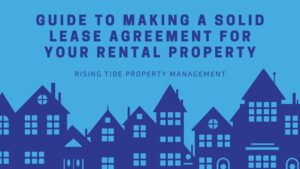Guide to Making a Solid Lease Agreement for Your Rental Property
As a landlord, one of the most crucial aspects of managing your rental property is creating a solid lease agreement. This document serves as the legal foundation for the relationship between you and your tenants, outlining the rules, responsibilities, and expectations for both parties.
A well-drafted lease agreement can help prevent disputes, protect your property, and ensure a smooth tenancy.
The Importance of a Strong Lease Agreement
A lease agreement is more than just a contract; it’s a comprehensive tool that defines the terms of a rental arrangement. Without clear and enforceable provisions, you might find yourself unprotected in cases of late payments, property damage, or other common issues. A solid lease agreement ensures that you:
- Set clear expectations for both parties.
- Protect your legal rights as a landlord.
- Minimize the potential for misunderstandings or conflicts.
- Outline procedures for common situations like rent payments, maintenance, and ending the tenancy.
Every lease should be customized to fit the specific needs of your property, your tenants, and local laws. Below are the essential elements to include in a strong lease agreement.
Key Elements of a Strong Lease Agreement
1. Tenant Information
The lease should clearly state the full names of all tenants who will reside in the property. This is essential for ensuring all adults living in the unit are legally responsible for following the lease terms and paying rent.
2. Property Details
Provide a clear and detailed description of the property being rented. Include the property’s address and any additional structures or amenities, such as a garage or storage unit included in the rental.
3. Lease Term
Specify the duration of the lease, whether it’s a fixed-term lease (e.g., one year) or a month-to-month arrangement. Clearly define the start and end dates of the lease to avoid confusion.
4. Rent and Security Deposit
Outline the rent amount, the due date each month, acceptable payment methods, and any late fees or penalties. Additionally, specify the amount of the security deposit and the conditions under which it will be returned to the tenant at the end of the lease.
5. Maintenance and Repairs
Clarify who is responsible for maintaining the property, handling repairs, and covering associated costs. Include specific details about routine maintenance, like lawn care or snow removal, and outline how tenants should report maintenance issues.
6. Property Use and Occupancy
Set rules regarding how the property should be used, such as prohibiting illegal activities or excessive noise. Include clauses about the number of occupants allowed and whether subletting or additional tenants are permitted.
7. Pet Policy
If pets are allowed, outline specific rules, such as the types of pets, weight limits, and any additional pet deposits or fees. If pets are prohibited, make this clear to avoid future disputes.
8. Lease Termination and Renewal
Explain the process for ending or renewing the lease, including notice periods required from both the tenant and landlord. Specify the conditions under which the lease may be terminated early, such as breaches of contract or nonpayment of rent.
9. Late Fees and Penalties
Detail the consequences of late rent payments or failure to comply with other lease terms. This might include late fees, eviction procedures, or other penalties for violating the lease.
10. Legal Requirements
Include all necessary disclosures required by law. This may vary depending on your state or local jurisdiction, but common disclosures include lead-based paint warnings or mold hazards.
Customizing Your Lease to Local Laws
While the above elements are fundamental to any lease agreement, it’s essential to customize the document to comply with your local landlord-tenant laws. Landlord-tenant regulations vary by state and even by city, covering areas like security deposit limits, notice periods, and rent control.
Ignoring local laws could leave you vulnerable to legal disputes and potential fines. Ensure that your lease agreement adheres to all applicable laws to protect you and your tenants.
Benefits of Working With a Professional Property Management Company
Drafting a solid lease agreement requires knowledge of legal terms, local laws, and the specific needs of your rental property. This is where working with a professional property management company can offer tremendous value.
1. Expertise in Lease Drafting
Property management companies have extensive experience creating lease agreements that comply with local laws and regulations. They can customize your lease to protect your interests while ensuring it’s enforceable in court. Their expertise helps avoid common pitfalls and ensures that your lease covers all necessary provisions to minimize the risk of legal disputes.
2. Clear Communication With Tenants
A property management company can act as a buffer between you and your tenants. They ensure that tenants fully understand the lease terms and are aware of their responsibilities. Clear communication reduces the likelihood of misunderstandings and disputes.
3. Staying Up-To-Date With Legal Changes
Landlord-tenant laws are constantly evolving. Professional property managers stay current with changes in rental regulations, ensuring your lease agreement remains compliant.
4. Handling Lease Enforcement
In the unfortunate event that a tenant breaches the lease, a property management company can handle the legal processes involved, such as issuing notices, pursuing evictions, and taking legal action if necessary. This takes the burden off of you and ensures that lease violations are addressed promptly and professionally.
5. Saving Time and Reducing Stress
Managing a rental property can be time-consuming and stressful, especially when it comes to legal matters like lease agreements. By partnering with a professional property management company, you can delegate these tasks and focus on other priorities, knowing that your lease and property are in good hands.
Bottom Line
Creating a solid lease agreement is a critical aspect of managing your rental property successfully. A well-crafted lease sets the foundation for a positive landlord-tenant relationship, protects your legal rights, and helps prevent disputes.
By including all necessary provisions, customizing the lease to your local laws, and avoiding common mistakes, you can ensure a smooth rental experience for both you and your tenants.
For landlords looking to streamline the process and avoid potential pitfalls, partnering with a professional property management company can be a wise investment. Contact Rising Tide Property Management for assistance.




